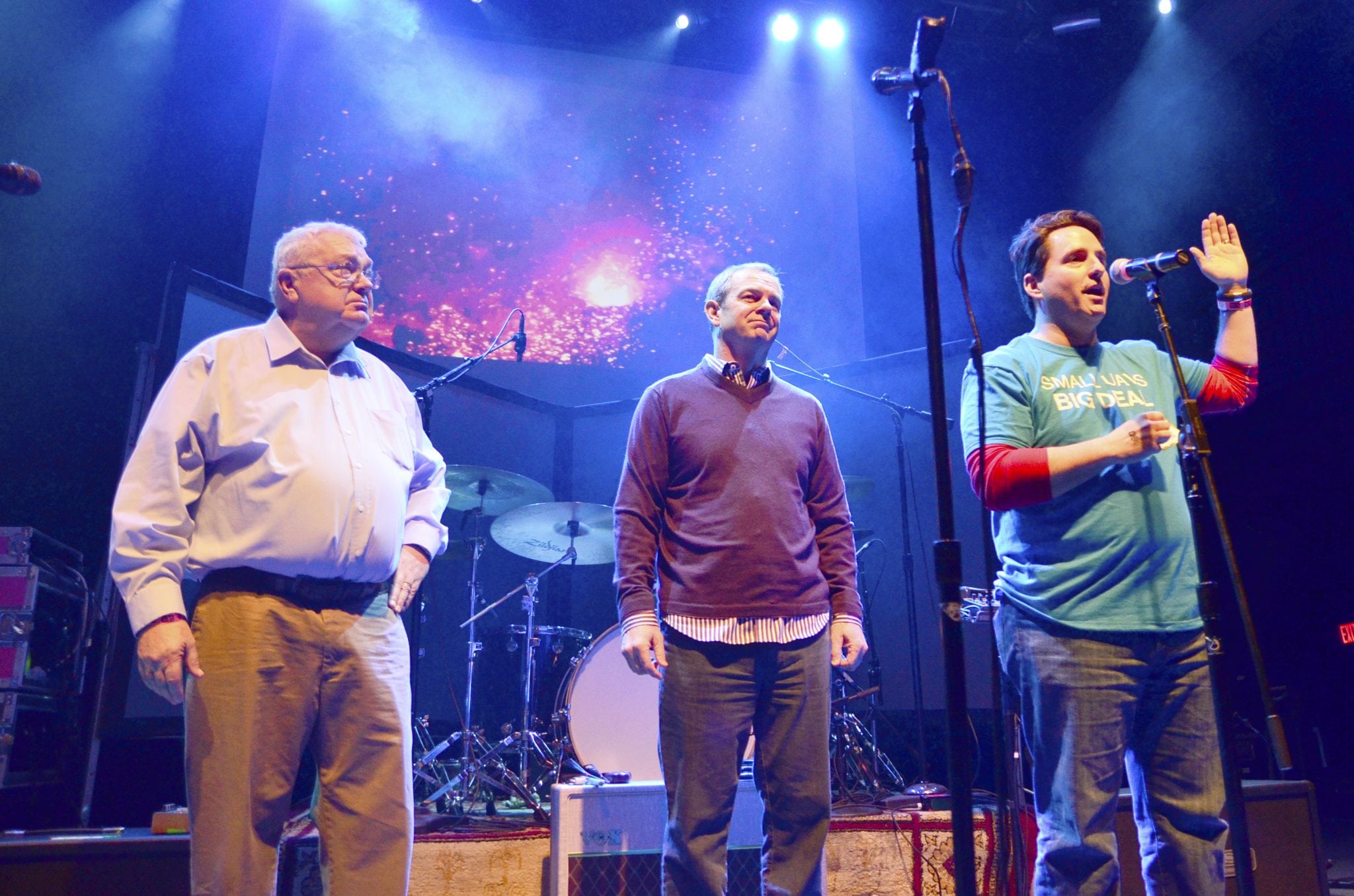[Avionics Today 01-22-2015] Unmanned Aerial Vehicle (UAV) enthusiasts of all ages gathered at the 9:30 Club in Washington, D.C. last night to support responsible UAV piloting alongside the Know Before You Fly campaign recently launched in conjunction with the FAA. Popular pop-rock artist Ok Go, — whose latest music video was shot in Japan using UAV aerial photography — headlined the free event, which was presented by the Small UAV Coalition, and touted backers such as the Association for Unmanned Vehicle Systems International (AUVSI), Google [X] and the Motion Picture Association of America (MPAA), among others.
 |
| From left to right: Bob Brown, President of Academy of Model Aeronautics, Brian Wynne, President and CEO at the Association for Unmanned Vehicle Systems International (AUVSI) and Michael Drobac, Executive Director of the Small UAV Coalition at the UAV Grassroots Know Before You Fly Concert on Jan. 21. Photo: Avionics Magazine/Veronica Magan |
The concert looked to promote a positive dialogue surrounding UAV use as well as encourage innovation and entrepreneurship in the industry.
“This is a process for these folks to learn about the industry but also for us to get away from [UAVs] being just about weapons,” said Jay Vincent, member of UAV Grassroots, the organization responsible for organizing and promoting the event.
The UAV Grassroots movement aims to shift much of the cultural consciousness surrounding UAV use and promote innovation in the way of new UAV technology and application. “This is not about weapons. This is instead about productive agriculture, search and rescue, environmental research, etc. The power of the sensors that come along with the infrastructure you need to operate [UAVs] safely is going to change the way we operate as a country,” Vincent told Avionics Magazine in an interview prior to the show.
Alongside encouraging a new understanding of UAV use, Vincent also hopes the movement will motivate hobbyists and small unmanned aircraft users to have a voice in the regulatory process the FAA is currently undertaking to put UAS rules in place for American air space. While the FAA still refuses to commit to a deadline for drafted regulations for commercial operation of small UAS weighing less than 55 pounds, Vincent believes hobbyists and entrepreneurs need to make their voices heard in the discussion.
“We’re about to enter a really important policy debate as a country and integrating these UAVs into our national civilian airspace is absolutely essential,” said Vincent.
The UAV Grassroots movement hopes to lend itself as a platform for those hoping to contribute to this upcoming debate.
“Many people in the SUAS [Small UAS] community feel like right now they don’t have a voice in this process and so you see this frustration come out online,” Vincent noted. “There is some anger for folks that are thinking that they are going to be restricted from doing this, which they view very much as the parochial interest as protecting itself. That tells me that there is a real entrepreneurial spirit in this community and we want to be a real platform for them to advocate for whatever their interests are.”
The FAA has already granted 14 total exemptions in the U.S. for commercial use of UAVs under Section 333 of the FAA Modernization and Reform act of 2012. These uses include oil rig monitoring and aerial photography as well as use by production companies for filming on movie sets — for which the MPAA has already seen positive results.
“We can do those shots now once deemed in the U.S. either impossible to too dangerous,” Lauren Reamy, director of government affairs at the MPAA, said at the event, citing UAS use on movies such as “Skyfall” and “Transformers: Age of Extinction.”
Many other uses for UAS are just coming to light, such as employing the tech in media coverage for news organizations, monitoring endangered species and providing precision agriculture. Once the FAA opens the airspace, the UAS industry is expected to boom. The FAA estimates that as many as 7,500 small, commercial UAS may be flying by 2018, with a study conducted by Texas A&M University showing that the UAS industry could contribute nearly $6.5 billion to the Texas economy alone between 2015 and 2025, once airspace is opened.
But before airspace can be opened, the FAA needs to establish policies. And the movement believes in stressing one point: “If UAV Grassroots had anything to say [about regulation] it’s this: size matters,” said Vincent. “But really what we are about is promoting a rational policy discussion versus, sometimes, the hysteria that gets talked about.”
And promoting that discussion is key to opening the door to a greater innovation in the United States’ UAS market.
“One of the positive outcomes of our work at UAV Grassroots is that if we are fighting for anything, it’s innovation,” stressed Vincent. “We want to see these companies innovate. And it’s not just about the guys building drones, it’s about the farmers that are going to collect data and figure out how to analyze their own soils and make enhancements to algorithms, etcetera; those are the guys that are really going to power this revolution, not just the manufacturers.”